-

人教版新课标小学数学四年级下册四则运算教案2篇
(1)请学生用和、差、积、商说说运算顺序。(2)计算,写出计算过程。(3)交流,改错。2、学校食堂买来大米850千克,运了三车,还剩100千克,平均每车运多少千克。(1)请两位同学来读题,其他同学来说一说你读懂了什么?(2)分析数量关系,列式解答,说说算式每一步的意思,再说说运算顺序,看看算式意思是否跟运算顺序相符合。3、下面四张扑克牌上的点数,经过怎样的运算才能得到24呢?你能想出几种方法?(1)先进行小组合作,看看哪个小组列出的算式最多。(2)交流,列出各种方法。(6+4-2)×3 6×4÷(3-2) 64、旅行社推出“××风景区一日游”的两种出游价格方案。(1)分析两种方案的意思。(第一种方案是按人数买,成人和儿童的票价不一样;第二种方案按团体计价,五人以上就一口价每人100元。)(2)共同解决第(1)小题,分别让学生按两种方案分别购票,看看哪种方案购票便宜一些?(3)独立解答第(2)小题。(与第(1)小题是同样道理)
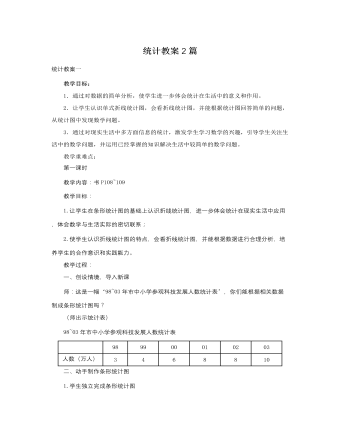
人教版新课标小学数学四年级下册统计教案2篇
制作前先让学生说说每格表示几个单位然后再制作统计图。2.小组交流作品,复习回顾‘条形统计图’的相关信息“制作步骤、特点”A学生根据条形统计图说说发现了哪些信息?B学生小组评价优秀作品;C全班交流优秀作品。三、对比条形统计图和折线统计图,认识折线统计图的特点1.师演示“98~03年市中小学参观科技发展人数折线统计图”,学生观察。师:这个统计图是怎样完成的?师和生一起分析折线统计图,教师演示其中的一个数据的画法,让生知道是这张统计图是如何画的。师:你们对比这两个统计图,看看它们有什么异同?学生先独立思考,再在小组内交流。2.小结:条形统计图和折线统计图相同点和不同点。教师把两种统计图的相同点和不同点板书出来。3.认识折线统计图,发现折线统计图的特点师:你能从折线统计图中发现哪些信息?有什么感想?引导学生观察参加科技发展人数的变化情况,并谈自己的感想,培养学生关心周围事物的兴趣并引导学生积极参加社会实践活动。
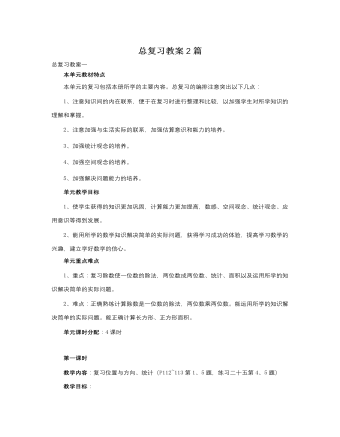
人教版新课标小学数学三年级下册总复习教案2篇
2、复习除数是一位数的除法时,通过让学生做第112页的第2题,了解学生计算时还存在什么问题,启发、引导学生发现自己的错误所在,并通过反思自己纠正;还应注意通过一定的练习使学生达到计算熟练。3、复习两位数乘两位数时,结合第113页第3题复习口算,结合第4题复习估算和笔算。教师针对计算中出现的问题进行订正,再通过练习二十五中的有关练习或出一些有针对性的练习,使全体学生达到本学期规定的教学目标。总复习:课题二1、复习统计时,让学生分析第113页第5题中的数据,对近年来该地区沙尘天气的发展变化趋势有一个判断;让学生谈谈感想,有什么办法减少沙尘天气,使学生受到环境保护的思想教育。2、复习年、月、日时,要注意全面复习学过的时间单位和有关知识,可借助表格进行系统整理时间单位,结合实例让学生体会这些单位的大小,培养学生的估计能力。
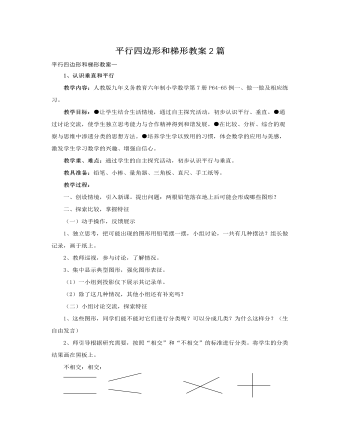
人教版新课标小学数学四年级上册平行四边形和梯形教案2篇
3、师:不相交的两条直线画长一些会怎样?量一量两条相交直线做组成的角分别是多少度?4、由小组同学在原记录单上动手合作操作,并进行讨论、汇报。5、师生共同总结:不相交的两条直线画长一些仍不相交,这两条直线叫平行线,也可以说它们相互平行;相交的两条直线形成的四个角,如果都是90度,就说这两条直线相互垂直,其中一条叫另外一条的垂线,这两条直线的焦点叫做垂足。6、生齐读P65平行和垂直概念,并画下来。7、今天我们就要一起来认识认识平行与垂直。(揭示课题)三、解释应用,巩固新知1、我们天天都在和垂线与平行线打交道:书本面相邻的两边是互相垂直的,相对的两边是互相平行的。2、P64主题图,找一找,图上有哪些平行和垂直的现象?3、做一做1找一找、想一想还有哪些物体的边是互相垂直的,哪些物体的边是互相平行的?
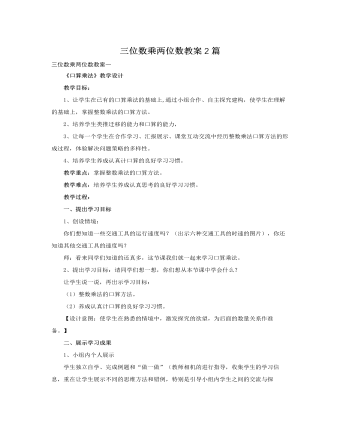
人教版新课标小学数学四年级上册三位数乘两位数教案2篇
教学目标:1、使学生能根据两位数乘两位数的笔算方法,推出并掌握三位数乘两位数的笔算方法。2、进一步培养学生的计算能力。教学过程:一、自主探索笔算方法。1、出示例1:李叔叔从某城市乘火车去北京用了12小时,火车1小时约行145千米。该城市到北京大约有多少千米?2、独立列式:145×12=3、请学生估一估145×12的大致范围。4、尝试算出145×12的结果,并对照估算的情况,算一算估算值与准确值的误差是否合乎实际。5、让学生说一说计算过程。应说以下几点:(1)先算什么;(2)再算什么,积的书写位置怎样;(3)最后算什么。6、师生共同归纳三位数乘两位数笔算一般方法的过程。7、引导学生用不同的方法检验自己运算的结果。二、巩固练习1、课本49页“做一做”学生独立用竖式计算,完成后,可能计算器自行检验。
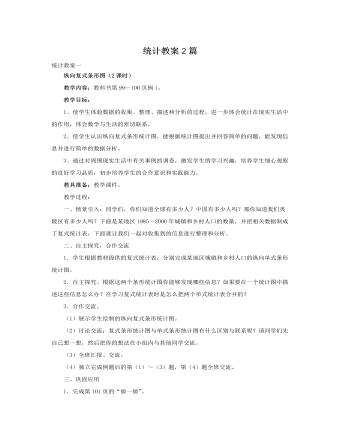
人教版新课标小学数学四年级上册统计教案2篇
教学目标:1、经历简单的收集、整理、描述和分析数据的过程。2、使学生初步了解数据的收集和整理过程,学会整理简单的数据,会看简单的统计表和统计图,会根据统计图表中的数据回答一些简单的问题。3、使学生体验解数据的收集、整理、描述和分析的过程,能发现信息并进行简单的数据分析。4、体会到数学知识与实际生活紧密联系,激发学生的学习兴趣,培养学生细心观察的良好学习品质。教学重点:绘制纵向复式条形统计图。教学难点:根据统计图发现问题、提出问题、解决问题。教具准备:课件。教学过程:一、情境导入:你们知道全球有多少人?中国有多少人吗?那你们知道自己所在的区有多少人吗?下面我们一起对收集到的信息进行整理和分析。二、探究新知:1、根据统计表,分别完成两个单式条形统计图2、根据两个条形统计图你能发现哪些信息?如果要在一个统计图中描述这些信息怎么办?在学习复式统计表时是怎么把两个单式统计表合并的?
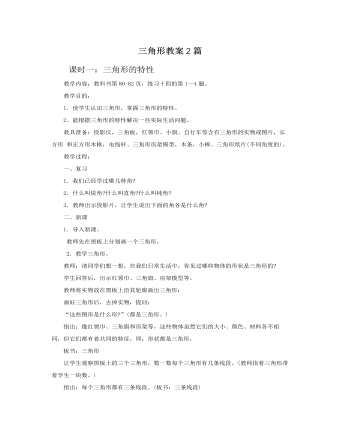
人教版新课标小学数学四年级下册三角形教案2篇
3学生探讨结束后让学生代表发言,总结归纳三角形三边的不等关系。学生代表可结合教具演示。教师问:我们是否要把三条线段中的每两条线段都相加后才能作出判断?有没有快捷的方法?(用较小的两条线段的和与第三条线段的大小关系来检验)。4得到结论:三角形任意两边之和大于第三边(电脑显示)。教师问:三角形的两边之和大于第三边,那么,三角形的两边之差与第三边有何关系呢?感兴趣的同学还可以下课继续研究。5巩固练习:为了营造更美的城市,许多城市加强了绿化建设。这些绿化地带是不允许踩的。(电脑动画演示有人斜穿草地的实践问题)。他运用了我们学习过的什么知识?6(1)有人说自己步子大,一步能走两米多,你相信吗?为什么?(由学生小组讨论后回答。然后电脑演示篮球明星姚明的身高及腿长,以此来判断步幅应有多大?)

人教版新课标小学数学四年级下册数学广角教案2篇
一、初步感知间隔的含义1、请同学们伸出右手,张开,数一数,5个手指之间有几个空格?在数学上,我们把 空格叫做间隔,也就是说,5个手指之间有几个间隔?4个间隔是在几个手指之间?2. 其实,这样的数学问题,在我们的生活中,随处可见。谁能举几个这样的例子3、看图:在画面上我们看到春天桃红柳绿,到处是一派生机勃勃的景象,你们知道吗?3月12日是什么日子,这一天全国上下到处都在植树,为保护环境献出自己的一份力量。 出示图:这里从头到尾栽了几棵树,数一数,它们之间又有几个间隔呢?你发现了什么?谁来说一说?同时板书。4、那你能像这样用一个图表示出来吗?请你们选择一种动手画一画吧!5、汇报:画了8棵树,他们之间有7个间隔数,9棵树之间有8个间隔。……6、你发现植树棵树和间隔数之间有什么规律呢?(自己先想想,再把你的想法和伙伴们互相交流一下)。反馈:谁来说说你的发现?评价:哦,这是你的发现……你还能用一个算式来概括。边板书边说:同学们都发现了从头到尾栽一排树时,植树棵树比间隔数多1,(指表格),也可以写成两端要栽时,植树棵数-间隔数+1,间隔数=植树棵树-1。
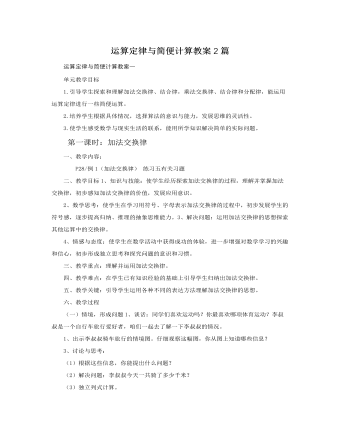
人教版新课标小学数学四年级下册运算定律与简便计算教案2篇
二、教学目标1、知识与技能:使学生经历探索加法交换律的过程,理解并掌握加法交换律,初步感知加法交换律的价值,发展应用意识。2、数学思考:使学生在学习用符号、字母表示加法交换律的过程中,初步发展学生的符号感,逐步提高归纳、推理的抽象思维能力。3、解决问题:运用加法交换律的思想探索其他运算中的交换律。4、情感与态度:使学生在数学活动中获得成功的体验,进一步增强对数学学习的兴趣和信心,初步形成独立思考和探究问题的意识和习惯。三、教学重点:理解并运用加法交换律。四、教学难点:在学生已有知识经验的基础上引导学生归纳出加法交换律。五、教学关键:引导学生运用各种不同的表达方法理解加法交换律的思想。六、教学过程(一)情境,形成问题1、谈话:同学们喜欢运动吗?你最喜欢哪项体育运动?李叔叔是一个自行车旅行爱好者,咱们一起去了解一下李叔叔的情况。1、出示李叔叔骑车旅行的情境图。仔细观察这幅图,你从图上知道哪些信息?
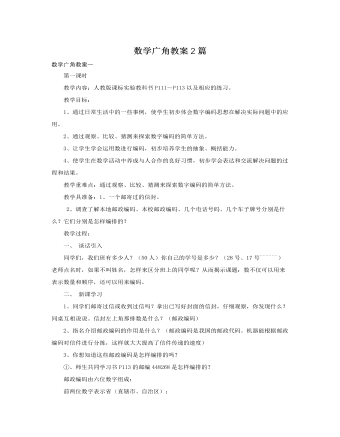
人教版新课标小学数学五年级上册数学广角教案2篇
虽然在此之前已经听过多节有关的研讨课,但临到自己教学时才真正体会到本课教学的艰难。一是信息化时代对邮政编码的冲突。其实我在教学前也仅仅只知道学校和家庭住址的邮编,至于邮政编码的结构含义等是完全陌生。在课堂前测中了解到,全班仅3人有写信寄信的经历(这三名学生的老家都远离湖北省),他们知道老家的邮编,全班有半数左右的家庭收集不到已经邮寄过的旧信封。可以说在学习本课前师生对邮政编码都是知之甚少,教师本身都只“半勺水”,何以给学生“一杯水”?虽然在课前布置学生收集了一些有关邮政编码的知识,自己也进行了大量的查询,但在实际教学中仍旧倍感吃力。如有学生质疑“为什么书上北京人民出版社的邮编是100008,它的第三、四位都是0呢”;“为什么我们学校的邮编4300XX第三、四位也是0呢”;“邮区是不是指什么市?”“邮区与市、区、县有什么关系?”一个接一个问题“炮轰”过来,着实招架不住。
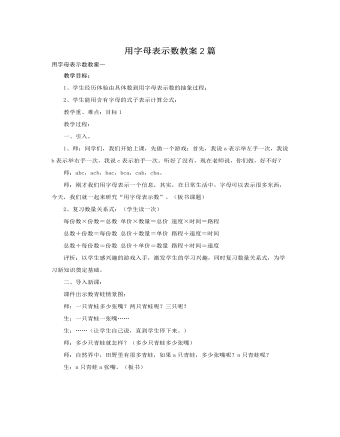
人教版新课标小学数学五年级上册用字母表示数教案2篇
教学目标:1、学生经历体验由具体数到用字母表示数的抽象过程;2、学生能用含有字母的式子表示计算公式;教学重、难点:目标1教学过程:一、引入。1、师:同学们,我们开始上课,先做一个游戏:首先,我说a表示举左手一次,我说b表示举右手一次,我说c表示拍手一次。听好了没有,现在老师说,你们做,好不好?师:abc,acb,bac,bca,cab,cba。师:刚才我们用字母表示一个信息,其实,在日常生活中,字母可以表示很多东西,今天,我们就一起来研究“用字母表示数”。(板书课题)2、复习数量关系式:(学生读一次)每份数×份数=总数 单价×数量=总价 速度×时间=路程总数÷份数=每份数 总价÷数量=单价 路程÷速度=时间总数÷每份数=份数 总价÷单价=数量 路程÷时间=速度评析:以学生感兴趣的游戏入手,激发学生的学习兴趣,同时复习数量关系式,为学习新知识奠定基础。
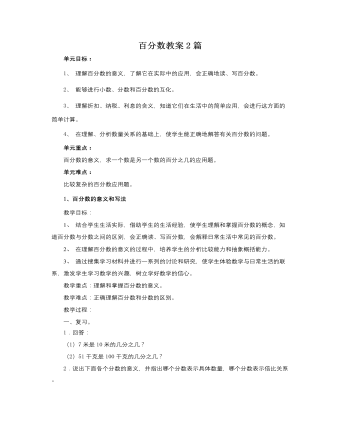
人教版新课标小学数学六年级上册百分数教案2篇
1、完成P78“做一做”第二题:读出下面的分数。2、完成P78“做一做”第一题:直接在书上的横线上写出对应的百分数。3、P79练习十九第4题:读出或写出报栏中的百分数。4、“做一做”第四题:学生根据自己的理解,说说分数和百分数在意义上有何不同。四、布置作业练习十九第1~3题。教学追记:本堂课,我从三个层次入手。第一层:联系生活实际引出百分数;第二层:理解百分数的具体含义;第三层:教学百分数的读写。三个层次,思路清晰,教学层次明显。其中,我把教学重点放在理解百分数的具体含义上,并及时与分数做了比较,教学结构较为严谨。2、百分数和分数、小数的互化教学目标:1、使学生理解并掌握百分数和小数互化的方法,能正确地把分数、小数化成百分数或把百分数化成分数、小数。2、在计算、比较,分析、探索百分数和分数、小数互化的规律的过程中,发展学生的抽象概括能力。3、通过探索百分数和分数、小数互化的规律,激发学生的数学探索意识。
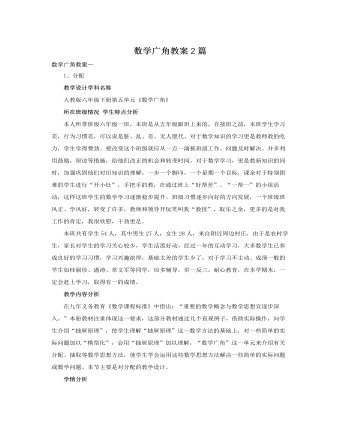
人教版新课标小学数学六年级下册数学广角教案2篇
一、创设情境,猜想验证1.猜一猜,摸一摸。一盒粉笔若干支,5种不同的颜色。至少摸几支能保证:(1)2支同色的。(2)3支同色的。(3)4支同色的。2.想一想,摸一摸。请学生独立思考后,先在小组内交流自己的想法,再动手操作试一试,验证各自的猜想。在这个过程中,教师要加强巡视,要注意引导学生思考本题与前面所讲的抽屉原理有没有联系,如果有联系,有什么样的联系,应该把什么看成抽屉,要分放的东西是什么。二、观察比较,分析推理1.说一说,在比较中初步感知。2.想一想,在反思中学习推理。三、深入探究,沟通联系四、对比练习,感悟新知1.说一说。把红、黄、蓝、白四种颜色的球各10个放到一个袋子里。至少取多少个球,可以保证取到两个颜色相同的球?2.算一算。向东小学六年级共有370名学生,其中六(2)班有49名学生。请问下面两人说的对吗?为什么?五、总结评价六、布置作业
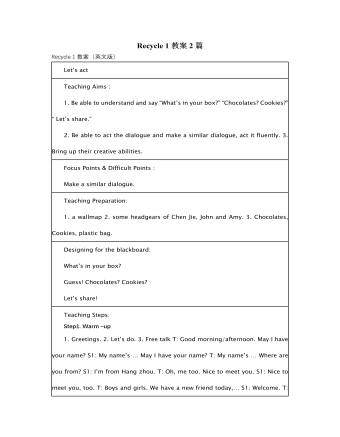
人教版新课标PEP小学英语三年级下册Recycle 1教案2篇
1.猜袋中东西数 将全班分成若干小组,每组抽一人到前面,背对着班级。教师拿一个袋子,并向学生们借一些书本,铅笔,钢笔,橡皮等,放入袋中,然后让各组学生轮流猜袋子里东西的数目,猜对的给该组记10分。 2.学生一起有节奏地说唱Let’s chant部分的歌谣,并请学生分角色表演。 (二)呈现新课 (Presentation) 1.抢读单词 教师将全班分成若干小组,然后逐个出示一些图片,学生们举手抢答,教师让最先举手的学生将图片的单词说出来,说对的给该组记10分,得分最多的组为优胜。 2.看单词卡读出单词并说出中文,复习1-3单元要求四会的单词。 3.教师用实物投影出示1-3单元课文中的某一幅图片,让学生根据图片内容进行对话练习。 4.让学生填写Assessment部分的内容,自己对1-3单元所学内容的掌握情况进行自我评价。 5.教师向学生出示已制作好的window card:This si a window card.并教读window card教师问学生:Do you like it? Can you make it? Do you want to learn how to make a window card?
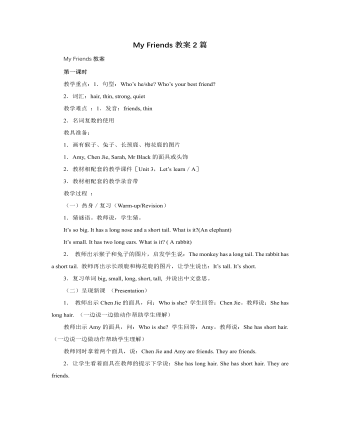
人教版新课标PEP小学英语四年级上册My Friends教案2篇
1.叫一名学生在班里走动,站在一名学生的后面。 2.教师举起一张本单元的单词图片。先正确地说出这个单词第一个字母的读音的学生坐下,另一名学生继续在班里走动,继续活动。 板书设计 :My friends 黑板上方:上课前打好的四线三格,在课堂上随讲随写的字母Ww, Xx, Yy, Zz 黑板下方: 教案点评: 本课时主要学习字母Ww, Xx, Yy, Zz及相关单词。因为本课时将结束字母的学习,因此在热身、复习环节,有必要先进行字母Aa-Vv的听写。然后出示字母卡、单词卡让学生认读字母和复习单词。呈现新课环节,教师可将字母教学放到单词中进行。在教学过程 中,教师结合图片或实物逐个进行字母和单词的教学,可辅以字母课件进行教学,便于学生更好的领会和掌握。教师要注意侧重字母的书写教学,使学生养成正确的书写习惯。两个小游戏“Bingo”和“Listen and show”帮助学生在趣味活动中巩固了所学的全部字母。扩展性活动的设计目的在于复习本单元的单词。
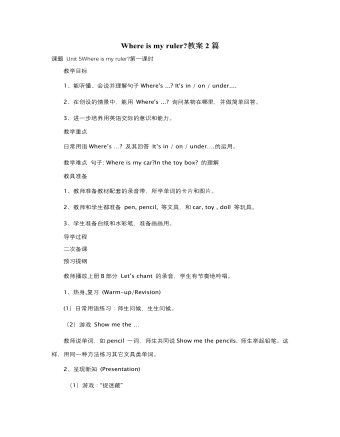
人教版新课标PEP小学英语三年级下册Where is my ruler教案2篇
1.Let’s say学习字母Uu, Vv, Ww,以及以这些字母开头的单词。2.Let’s do本部分通过有韵律的歌谣,来复习巩固A-W的字母。【教学重点】学习字母Uu, Vv, Ww及以其为首字母的单词【教学难点】单词umbrella, violin, wind和字母Uu, Vv, Ww的发音.【教具准备】1 教师准备教材配套的录音带。2 教师准备 umbrella, vest, violin, window, wind 的图片和词卡。3 教师准备字母卡 Aa----Ww 。【教学过程】1 热身、复习 (Warm-up/Revision)(1)Oral practice学生口语会话展示。教师可根据学生情况提示他们增加对内容。(2)游戏:“猜猜看”。教师用简笔画的方法在黑板上画某种交通工具的某个部位,边画边问:What is it? 学生随意想象,猜图说:A panda? A jeep? A pear? … 教师再继续画一两笔,让学生接着猜,并以小组为单位讨论,最后由一名学生代表说出一个答案。教师将图画完,带领学生一起说: Look! It’s a … 猜对的小组赢得一分。(以交通工具、玩具和文具词为主) 还可让学生代替教师进行此项活动。
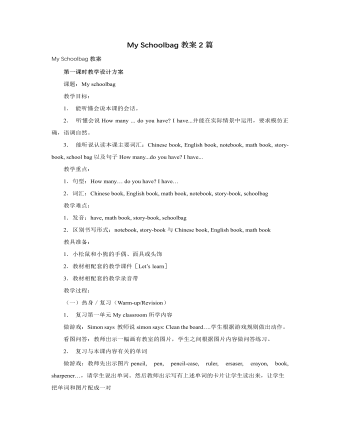
人教版新课标PEP小学英语四年级上册My Schoolbag教案2篇
教师问:Can you spell these words? 如有学生能够拼出单词,教师要给与表扬并说:那让我们来看一看他拼的对不对,然后出示单词卡。如没有学生拼出单词,教师说:我们学习单词不仅要会说还要会写,今天我们就来学习几个单词的拼写,看谁学得快。然后出示单词卡。 让学生看单词卡拼读单词。 教师让学生看单词回答:How many letters in this word?学生回答后,让他们背着拼出单词。 教师让学生在四线三格中默写字母b, o, k, r, l, e, p, n, c, I, a,教师教学生在四线三格中书写单词。告诉学生首先要把每个字母书写正确,然后按照单词的拼写把字母写在一起,注意单词的每个字母间要有一点距离。教师在教写ruler和pencil-case时, 注意小写u和s还没有学习书写,让学生照着板书写就可以了。 让学生照板书抄字头,然后每个单词写一行。 (三)趣味操练(Practice)
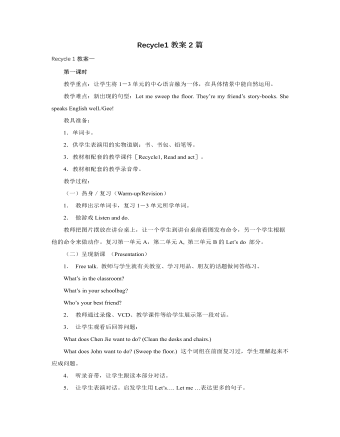
人教版新课标PEP小学英语四年级上册Recycle1教案2篇
Part two1. Teaching AimsMaster the 26 letters.Master the pronunciation of the letters.2. Teaching Aidsa tape-recorder, some cards, some papers and so on.3. Important pointsThe pronunciation of the letters4. Teaching steps1) Greetings and revisionLet some groups act out the dialogue in the last lesson.2) New contentsLet them say out the 26 letters and let some ones say them out.Then listen and learn the letters song.First, give them some minutes and let them read the letters. Let’s see whether there is anyone who can learn anything in them. Then give them some information and let them read again. At last, give them the answer and read again.Let them remember it.PracticeShow the cards where are written the math patterns and let some answer it. Then ask “Who can read it in English?” Let some one read it. Others follow him.Next, show the cards and ask others answer them. T asks and S answers. Then S asks and S answers. Practice in pairs.HomeworkMaster the letters.Teaching notesPart three1. Teaching AimsIntroduce self and others using the words and phrases.Let’s play.2. Teaching Aidsa tape-recorder, some cards3. Important pointsShe has…She likes…I have…4. Teaching stepsGreetings and revisionLet some one read the letters and divide them by the pronunciations.
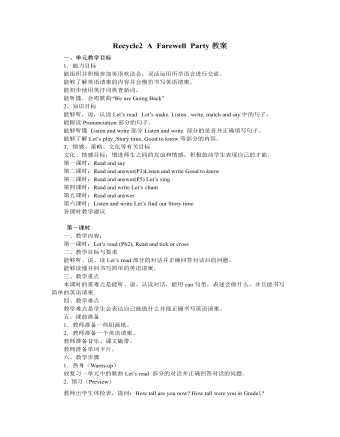
人教版新课标PEP小学英语六年级下册Recycle2 A Farewell Party教案
3. 新课呈现(Presentation) Let’s make (1)教师说:Miss White is making a book about her students. So she can remember them well.Who are the students? 请学生独立或分小组朗读四段短文,解释学生不理解的句子,然后说:There are four pictures below. Would you like to help Miss/White glue the pictures? 教师知道学生完成图文搭配的练习。 (2)教师发给每名学生一张铅画纸,说:Now please draw a picture of your best classmate. Then describe him or her.学生画一副最要好的同学的肖像,并在傍边配上对该同学的英语介绍。 学生上讲台介绍自己最要好的同学,请其他学生猜是谁,看谁说的生动又贴切,教师给予评价时注意强调第三人称单数形式的使用。 Story time 教师向学生展示Story time部分的教学挂图,指着最后一副图中的Zoom 和 Zip说 Look at the picture. Zoom and Zip are sad. They are saying goodbye to each other. Now let’s see What happened. 学生同桌之间合作阅读或是,然后教师提出问题Where is Zip going? Is this good news for zoom ? What grade is Zip going to be in? 教师放录音,学生录音跟读故事,然后再分角色朗读.
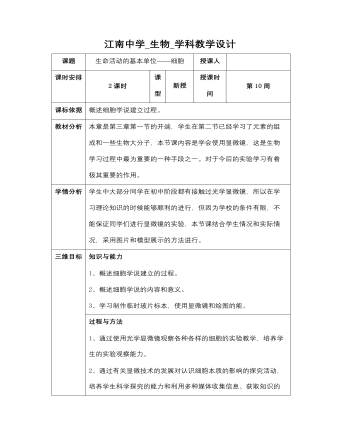
高中生物苏教版必修一《31生命活动及本单位-细胞》教案
本章是第三章第一节的开端,学生在第二节已经学习了元素的组成和一些生物大分子,本节课内容是学会使用显微镜,这是生物学习过程中最为重要的一种手段之一。对于今后的实验学习有着极其重要的作用。 学生中大部分同学在初中阶段都有接触过光学显微镜,所以在学习理论知识的时候能够顺利的进行,但因为学校的条件有限,不能保证同学们进行显微镜的实验,本节课结合学生情况和实际情况,采用图片和模型展示的方法进行。 知识与能力 1、概述细胞学说建立的过程。 2、概述细胞学说的内容和意义。 3、学习制作临时玻片标本,使用显微镜和绘图的能。

